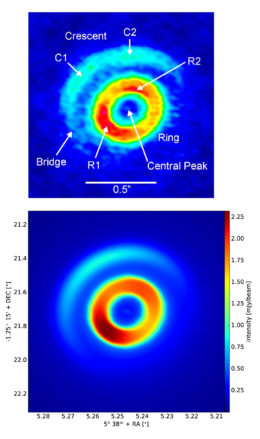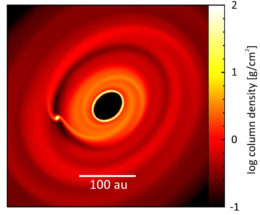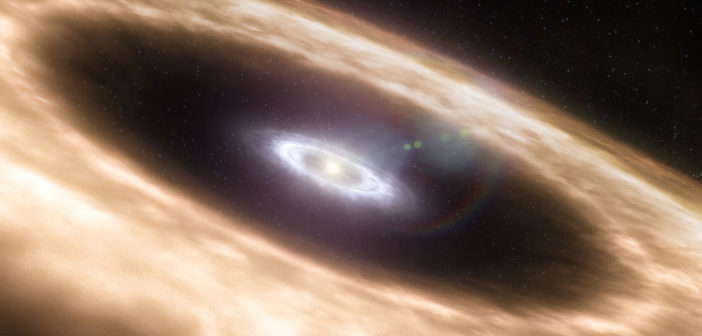Growing a planet from a dust grain is hard work! A new study explores how vortices in protoplanetary disks can assist this process.
When Dust Growth Fails

Top: ALMA image of the protoplanetary disk of V1247 Orionis, with different emission components labeled. Bottom: Synthetic image constructed from the best-fit model. [Kraus et al. 2017]
The radial drift problem acknowledges that, as growing dust grains orbit within the disk, the drag force on them continues to grow as well. For large enough dust grains — perhaps around 1 millimeter — the drag force will cause the grains’ orbits to decay, and the particles drift into the star before they are able to grow into planetesimals and planets.
A Close-Up Look with ALMA
So how do we overcome the radial drift problem in order to form planets? A commonly proposed mechanism is dust trapping, in which long-lived vortices in the disk trap the dust particles, preventing them from falling inwards. This allows the particles to persist for millions of years — long enough to grow beyond the radial drift barrier.
Observationally, these dust-trapping vortices should have signatures: we would expect to see, at millimeter wavelengths, specific bright, asymmetric structures where the trapping occurs in protoplanetary disks. Such disk structures have been difficult to spot with past instrumentation, but the Atacama Large Millimeter/submillimeter Array (ALMA) has made some new observations of the disk V1247 Orionis that might be just what we’re looking for.
Trapped in a Vortex?
ALMA’s observations of V1247 Orionis are reported by a team of scientists led by Stefan Kraus (University of Exeter) in a recent publication. Kraus and collaborators show that the protoplanetary disk of V1247 Orionis contains a ring-shaped, asymmetric inner disk component, as well as a sharply confined crescent structure. These structures are consistent with the morphologies expected from theoretical models of vortex formation in disks.
Kraus and collaborators propose the following picture: an early planet is orbiting at 100 AU within the disk, generating a one-armed spiral arm as material feeds the protoplanet. As the protoplanet orbits, it clears a gap between the ring and the crescent, and it simultaneously triggers two vortices, visible as the crescent and the bright asymmetry in the ring. These vortices are then able to trap millimeter-sized particles.

Gas column density of the authors’ radiation-hydrodynamic simulation of V1247 Orionis’s disk. [Kraus et al. 2017]
How can we confirm V1247 Orionis provides an example of dust-trapping vortices? One piece of supporting evidence would be the discovery of the protoplanet that Kraus and collaborators theorize triggered the potential vortices in this disk. Future deeper ALMA imaging may make this possible, helping to confirm our picture of how dust builds into planets.
Citation
Stefan Kraus et al 2017 ApJL 848 L11. doi:10.3847/2041-8213/aa8edc



4 Comments
Pingback: Dust trapping vortices enable planet formation
Pingback: Trapping Dust to Form Planets – MeasurementDataBases for Industry & Science
Pingback: ALMA descubre polvo frío alrededor de la estrella más cercana – Asociación de Aficionados a la Astronomía del Uruguay
Pingback: Pebbly Planets | astrobites